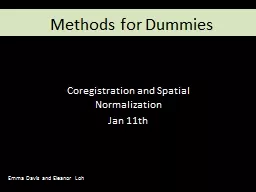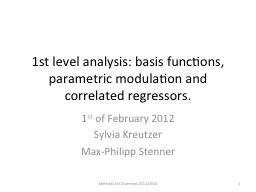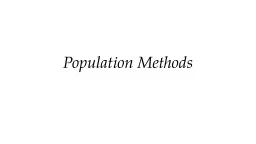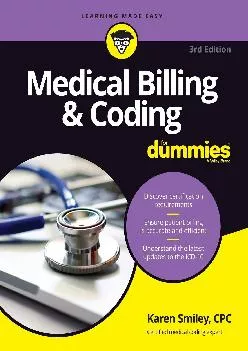PPT-Methods for Dummies
Author : cheryl-pisano | Published Date : 2016-02-23
Coregistration and Spatial Normalization Jan 11th Emma Davis and Eleanor Loh fMRI fMRI data as 3D matrix of voxels repeatedly sampled over time fMRI data analysis
Presentation Embed Code
Download Presentation
Download Presentation The PPT/PDF document "Methods for Dummies" is the property of its rightful owner. Permission is granted to download and print the materials on this website for personal, non-commercial use only, and to display it on your personal computer provided you do not modify the materials and that you retain all copyright notices contained in the materials. By downloading content from our website, you accept the terms of this agreement.
Methods for Dummies: Transcript
Download Rules Of Document
"Methods for Dummies"The content belongs to its owner. You may download and print it for personal use, without modification, and keep all copyright notices. By downloading, you agree to these terms.
Related Documents






![[EPUB] - Arabic For Dummies (For Dummies (Language & Literature))](https://thumbs.docslides.com/900895/epub-arabic-for-dummies-for-dummies-language-literature.jpg)
![[READ] - Chemistry For Dummies (For Dummies (Lifestyle))](https://thumbs.docslides.com/900900/read-chemistry-for-dummies-for-dummies-lifestyle.jpg)
![[EPUB] - Japanese For Dummies (For Dummies (Language & Literature))](https://thumbs.docslides.com/900995/epub-japanese-for-dummies-for-dummies-language-literature.jpg)
![[DOWNLOAD] - Basic English Grammar For Dummies - US (For Dummies (Language & Literature))](https://thumbs.docslides.com/901626/download-basic-english-grammar-for-dummies-us-for-dummies-language-literature.jpg)
![[DOWNLOAD] - Basic Math and Pre-Algebra Workbook For Dummies (For Dummies (Lifestyle))](https://thumbs.docslides.com/901774/download-basic-math-and-pre-algebra-workbook-for-dummies-for-dummies-lifestyle.jpg)



